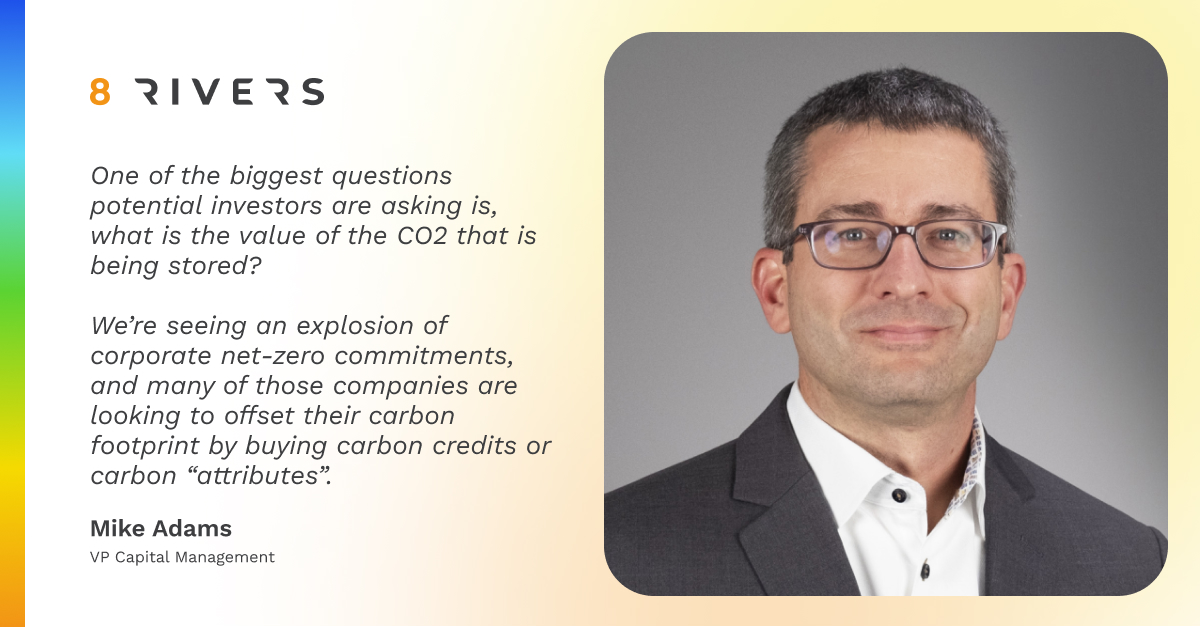Decarbonization is more than just an environmentalist’s dream—it is a market opportunity potentially worth trillions. As financing models take shape for capital-intensive projects in carbon capture and sequestration (CCS), clean hydrogen and more, questions linger, especially around the “marketization” of carbon dioxide and how big bets will pay off.
After spending his time speaking with other senior energy finance experts at CERAWeek, 8 Rivers’ VP for Capital Management Mike Adams shared the ways his views on the future of carbon markets have changed, and how to navigate the headwinds buffeting climatetech finance.
What were your biggest takeaways from CERAWeek?
To me, what CERAWeek made clear was the level of interest across multiple industries in figuring out the energy transition, and especially in CCS. It underscored how much shared uncertainty there is about how we’re actually going to make it happen, but there’s clear dedication from the industry, including oil and gas, to figure it out. Not everyone had answers yet, but everyone seemed ready to walk down that path.
Given the focus on CCS at CERAWeek, could you describe the project financing landscape for CCS in particular right now? How are investors assessing its prospects, especially with regard to viable business models?
One of the biggest questions potential investors are asking is, what is the value of the attribute—namely, the CO2—that is being stored? We’re seeing an explosion of corporate net-zero commitments, and many of those companies are looking to offset their carbon footprint by buying carbon credits or carbon “attributes”. To explain a bit here, a carbon neutral attribute means the commodity was produced without emitting any CO2, while a carbon negative attribute means that CO2 was actually removed from the atmosphere in the lifecycle of the fuel or commodity involved.
Unfortunately, however, the current market for offsets is just not that good. Options like reforestation and the like are rife with problems. Purchasing a carbon credit or energy with a carbon neutral/negative attribute will become an increasingly attractive option, but only if there’s a clear value on the CO2 itself.
The same question applies to the nascent market for clean fuels, like green or blue hydrogen and ammonia. How much should a company have to pay a holder of a carbon credit for the right to claim that credit toward its net-zero goal? You have to guarantee that the CO2 was actually stored, say, or that the hydrogen was produced with low or zero carbon intensity.
How do you see the market for CO2 offset credits actually taking shape?
You’re going to see multiple organizations emerge that will play a role similar to today’s credit ratings agencies. An operator of a CCS project, for instance, will submit its documentation to one of these registries and receive a certification. They can then go to a corporate offset buyer and receive payment for the carbon they’re storing. This has been tried before in the voluntary carbon markets. Some legacy and some new companies are springing up to try again with the tailwind of better measurement and verification and stronger, more visible corporate commitments.
How does the Inflation Reduction Act (IRA) support market development?
The IRA’s impact has been substantial, and not just because it dramatically increased the value of the tax credits for storage and clean fuels. It introduced direct pay, meaning that there are no intermediaries that need to get involved or complicated accounting that needs to take place in order for people to get paid. An operator can now sequester a ton of CO2 and receive money directly from the federal government, simple as that. This lowers the market price of the CO2 offsets generated off the back of those tax credits, opening the market to vastly more participants than would otherwise be the case. It’s transformative.
What is your take on the market for direct air capture (DAC) in particular?
It’s remarkable how a few big buyers have stimulated so much recent activity by pooling demand. Developers can now go to potential investors and say, “For these types of projects, I now have two legitimate revenue streams: first, the IRA, and second, these big buyers.”
The question over the long run will be, how much does that demand pool expand? Are these early movers who have created this market correct in that DAC credits are the most validated, verifiable CO2 credits available, and therefore justify a higher price? That remains an open question for now.
Shifting gears from project finance and carbon markets to corporate fundraising, it has been a tough several months for venture-backed companies. Do you think climate tech is bucking this trend? Are we in for another startup winter like what we experienced after the 2008 financial crisis?
Different pieces of the decarbonization ecosystem are at different stages of the hype cycle. If you think back to cleantech 1.0, it was pretty much all about wind and solar. Those markets have basically become “boring” now. It goes to show that if you can weather the turbulence, there’s long-term growth in technologies that will fight climate change. It’s definitely possible we could endure another startup winter, but the long-term trajectory for decarbonization and CO2 management is positive—we just have to navigate through it.
Follow us on LinkedIn for more climate policy, project finance, and net zero content.
